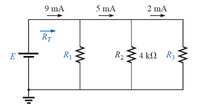Question
For the circuit below. Hint: First determine the current flowing into each resistor. The current flowing into R1=9mA-5mA. Then use the fact that voltage loss is equal across all parallel branches to solve for the missing resistances. ΔV1=ΔV2, R1I1=R2I2
Determine R1. (enter units as kΩ)
Determine R3 (enter units as kΩ)

Transcribed Image Text:5 mA
2 mA
9 mA
RT
R1
R2
4 kΩ R3
E
Expert Solution
This question has been solved!
Explore an expertly crafted, step-by-step solution for a thorough understanding of key concepts.
Step by stepSolved in 4 steps with 3 images

Knowledge Booster
Similar questions
- please answer all partsarrow_forwardThe resistance between terminals a and b in the figure below is 65 . If the resistors labeled R have the same value, determine R. R = 22 a. W R b. 120 Ω Σ Σ 40 Ω R www 5.0 Ω . @arrow_forwarda) Write an equation for the currents entering in/out of the top junction in Figure 1. Use I1 as the current coming from the left, I2 as the current going downward, and I3 as the current going to the right. b) You can draw three loops in order to solve this circuit. Write the corresponding voltage equations for these loops in terms of V1, V2, VA, and VB; where VA and VB are voltages across the resistors RA and RB respectively. c) Using Ohm's law combined with the equations you found above; express I1, I2, and I3 as equations in terms of the know quantities V1, V2, RA, and RB. d) Now you have all the information you need to express VA and VB as equations in terms of V1, V2, RA, and/or RB.arrow_forward
arrow_back_ios
arrow_forward_ios